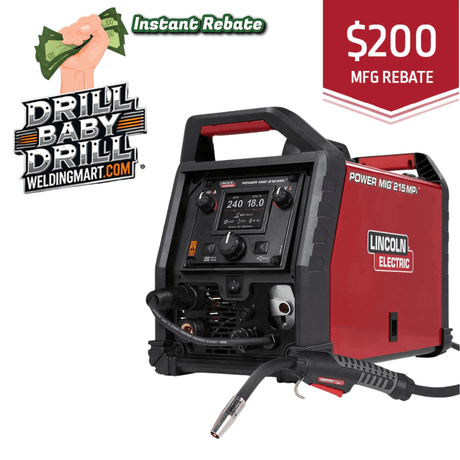Shop durable stick and arc welders designed for tough jobs in construction, repair, and metal fabrication. Perfect for outdoor use and heavy materials, these machines deliver reliable performance and portability—featuring trusted models from Lincoln Electric and other leading brands.
-
Lincoln Power MIG 140 MP Multi-Process Welder TIG One-Pak Welding Package - K4499-1
$1,679.99Unit price /UnavailableLincoln Elevate SLi Battery-Powered Welder with Rolling Case Package - K5622-1
$4,119.99Unit price /UnavailableLincoln Elevate SLi Battery-Powered Welder TIG and Rolling Case Package - K5624-1
$4,459.99Unit price /UnavailableThe Ultimate Guide to Stick and Arc Welders: Everything You Need to Know
You'll discover everything about arc, stick, and TIG welding machines, including their accessories and connections.
Introduction to Welders
What Are Stick and Arc Welders?
Stick welding machines, like the Lincoln Electric models, provide effective solutions for industry professionals and DIY enthusiasts. Stick welders are versatile tools known as arc welders or stick welding machines, and they use electric current to join metals. The process—formally called Shielded Metal Arc Welding (SMAW)—uses a consumable electrode (the “stick”) that melts and fuses metal pieces together. With simplicity and adaptability at their core, stick welders are widely popular among DIY enthusiasts and professionals alike.
Arc welding is a broader term that refers to various welding processes using an electric arc to create heat for melting metals. Stick welding is one of the most common arc welding methods, making these terms often interchangeable.
Applications of Stick and Arc Welding
These processes are powered by reliable Lincoln Electric products known for their performance in diverse conditions. Stick and arc welding machines are valued for their ability to work in diverse environments and on different metals. Key applications include: - Construction and repair projects - Farm equipment maintenance - Pipeline and structural welding - Automotive repairs - DIY projects at home or in workshops
This process operates well outdoors and on rusty or dirty materials, making it suitable for heavy-duty repairs.
Types of Welders
Stick Welders vs. Arc Welders
While all stick welders are arc welders, not all arc welders are stick welders. Arc welding encompasses several processes including TIG (Tungsten Inert Gas) welding, but stick welding machines specifically use electrode rods for reliable work. Choosing between these options depends on your project requirements: - Stick welders: Best for portability, welding thicker materials, and outdoor use. Stick welding machines provide the power and the new AC DC options favored for thick materials. - Other arc welders (MIG/TIG): Suitable for cleaner, more precision-based work, such as automotive or artistic metalwork.
Brands and Their Offerings
Explore the features of Lincoln Electric and other top brands to find the right welder for your projects. Manufacturers provide a range of stick and arc welders to suit different needs: - Lincoln Electric is renowned for rugged stick welding machines like the Lincoln Stick Welder and versatile arc models. - Miller: Offers user-friendly, durable welding equipment for both hobbyists and professionals. Their durable products allow for excellent welding performance. - YesWelder: Known for affordable, high-performance machines, often geared towards beginners and home workshops.
When selecting a model, ensure it matches your skill level, application, and power requirements, examining the options from Lincoln or Miller.
Best Practices for Welding
Techniques to Improve Weld Quality
To master stick welding and achieve strong, clean welds, consider the following practices: - Maintain a consistent electrode angle—usually 15° from vertical. - Keep a steady hand and consistent travel speed. - Select the right electrode type and diameter for your material. - Clean the workpiece to remove excessive rust, paint, or oil. This ensures better arc quality and produces a sturdy weld.
Key Features to Look for in a Welder
When choosing a stick or arc welder, consider key features: - Check the amperage range to match the thickness of metals you'll weld. This ensures optimal output. - Portability: Lightweight, easy-to-carry models for job site flexibility. - Durability: Sturdy build to withstand demanding environments. Digital displays and controls help make operation easy. - Ease of use: Simple controls and clear documentation, especially for beginners. Seek a welder that offers a digital display with free access to helpful resources like videos and tips.
Safety Precautions in Welding
Proper safety gear is vital for welding projects, providing protection with the right item: - A welding helmet with an auto-darkening filter - Fire-resistant gloves and clothing - Safety glasses or goggles - Welding boots with steel toes - A respirator if in poorly ventilated areas.
Proper safety gear is vital for all welding projects, including: - Welding helmet with an auto-darkening filter - Fire-resistant gloves and clothing - Safety glasses or goggles - Welding boots with steel toes - Respirator or mask if working in poorly ventilated areas
Safety Guidelines to Follow
Always adhere to these safety basics: - Work in a well-ventilated area to avoid inhaling fumes. - Keep a fire extinguisher nearby. - Double-check all equipment for damage or exposed wires before starting. - Store electrodes and flammable materials safely.
Common Challenges in Welding
Identifying Defects
Watching videos on effective techniques can help identify problems faster. Common welding defects include: - Cracks in the weld - Porosity (holes from trapped gas) - Slag inclusions (non-metallic material in the weld) - Poor fusion or incomplete joint penetration
Solutions to Common Welding Issues
To overcome frequent welding problems: - Choose the correct electrode and amperage for your project. - Clean work surfaces beforehand. - Adjust travel speed and angle to prevent undercutting or excessive buildup. - Practice on scrap material to perfect your technique. Producing high-quality welds involves controlling the arc and current effectively.
Stick and arc welders are indispensable for welding projects, from repairs to fabrications, as they allow you to work effectively. By understanding machines like the Lincoln stick welder, following best practices, and prioritizing safety, you'll achieve professional-grade results with your stick welding machine, whether it's a Lincoln, Miller, or another leading brand on the market.
Stick Welders Questions & Answers



















